DIGS O’ THE DAY (2010-03-14): BACK TO BLACK BANKS
 lordmarcovan
Posts: 44,070 ✭✭✭✭✭
lordmarcovan
Posts: 44,070 ✭✭✭✭✭
DIGS O’ THE DAY (2010-03-14): BACK TO BLACK BANKS
In the spring of 1999, I had the opportunity to search the yard of the Hartridge residence, which I’m told is the oldest inhabited house on St. Simons Island. The Hartridge’s daughter, Trina, was a classmate of mine in high school and is currently a sales manager where I work. I don’t remember how the subject came up originally, but when Trina mentioned her parents owned land in the Black Banks area of the island, my interest was piqued, as Black Banks was the site of an antebellum plantation. Through Trina’s introduction, I was permitted to hunt the yard of her parents’ home, which was built in 1876, a short distance away from where the original plantation house once stood. It is, to my knowledge, the only Victorian house still standing on the island, though Old Town Brunswick on the mainland has dozens if not hundreds of them.
Though I dug no 19th century coins, the hunting there was very productive, and several silver coins turned up. There were two Barber dimes dated 1914 and 1916. The 1916 was in exceptional condition- almost Mint State, with much of the original luster remaining- and is probably the best Barber dime I’ve found so far. It was probably lost not too long after it was made. (For my non-numismatic readers, I should explain that the “Barber” coins of 1892-1916 get their name from William Barber, the Mint engraver who designed them. Many probably did get spent on haircuts, too, though.)
There were also two “Mercury” or Winged Liberty dimes. The first was only about two-thirds of a coin. It had been melted in a fire and was thin, brittle, and stretched out much larger than a normal dime. The first portion of the date appeared to read “191”, so it would have been struck in 1916 or 1917. It was cracked when I found it, and now, after eleven years in my dug coin album, it has disintegrated into small crumbs of metal. I never found the rest of it. The other Mercury dime was dated 1926.
Another silver coin found was a British shilling from 1941. It bore the portrait of King George VI on the obverse. This type of shilling was made with two different reverse designs: “English” and “Scottish”, and mine had the Scottish lion on it.
There is also a sixth silver coin from around that time in my dug finds book- it is a 1946 Roosevelt dime- but I don’t know if it came up at the Hartridge house or on a subsequent site, since my recordkeeping lapsed for a while.
In summary, this site was very good to me in the past, and I knew I’d been the first to detect there. I also knew I’d barely scratched the surface, and plenty of goodies were sure to remain. Needless to say, I was excited when I was recently granted permission to return.

On Sunday, March 14, 2010, I crossed the Torras Causeway to the island. It was a partly cloudy and rather cool day, and the Bach cantatas playing on my car radio suited the mood nicely. Since metal detecting is a journey into the past, I often listen to classical music to put me in a historical frame of mind.
As I approached the Hartridge house, it didn’t look very different from how it had eleven years before. The entire neighborhood had become a gated community, but little else appeared to have changed.



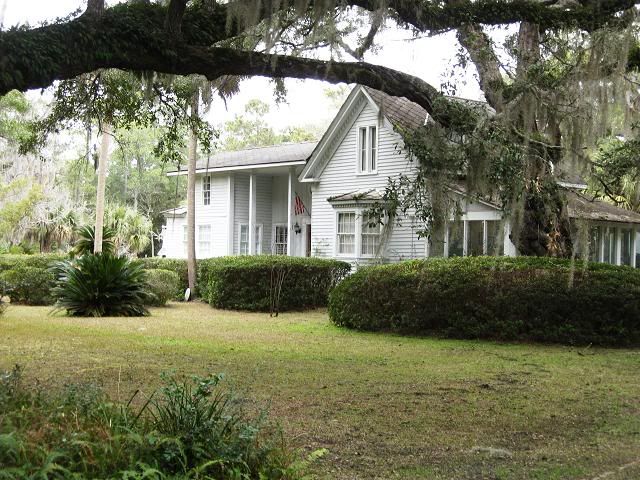
Mrs. Hartidge greeted me at the gate and offered to show me where the property boundaries lay. It turned out there was a very great deal more property than just the yard around the house. In fact, the whole tract was something like eleven acres. Eleven acres on Saint Simons Island… wow. There aren’t many folks who have tracts of land that size on the island, unless the property has descended through several generations of an old family, which this one no doubt has.
A lot of this acreage is still partially wooded and Mrs. Hartridge said she didn’t believe it had ever been touched by a metal detector. Though I had hunted the yard before, it remained my primary focus for today, since old coins are my chosen quarry, and they tend to be closer to the house in yards like this. Since Mrs. Hartridge graciously extended permission for me to come back anytime I liked, the other parts of the property would definitely bear further investigation later on.
My first target in the yard registered as a good coin signal on the detector’s meter. It proved to be a fragment of an old Mason jar lid, however. The next signal was difficult to pinpoint at first, but it ended up being a buried electrical cable. Fortunately I hadn’t damaged the tough rubber insulation around it. I made a mental note to myself to dig carefully around here, since electrocuting myself or knocking out my hosts’ power didn’t seem like much fun.
In the northwestern corner of the yard, near where a part of the marsh wrapped around the property, there was a lichen-encrusted cedar tree. Beneath it there was a patch of brilliant green grass. It was of a different type than the rest of the lawn, and looked like the stuff used to line kids’ Easter baskets- maybe even brighter than that. It was almost a fluorescent green. I don’t know why a little patch of bright green grass brightened my spirits, but it did. Maybe it's the symbolism behind that whole "looking for greener pastures" thing.
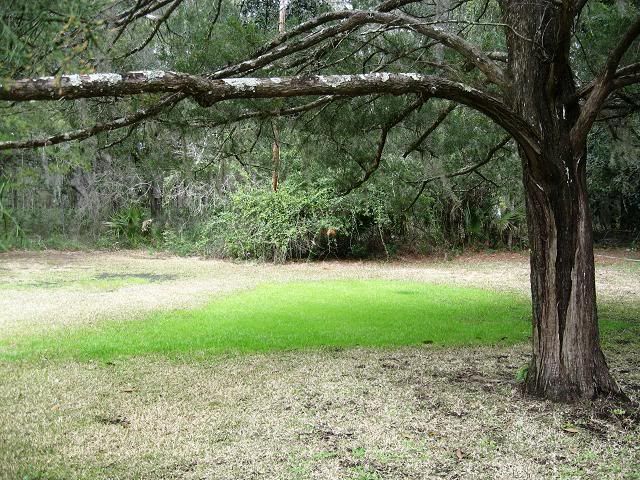
In another sign of spring, the azaleas were beginning to bloom, and the sound of birdsong was in the air. There were several handsome sago palms in the yard. Near one of them, I dug a small brass doodad, which had probably been a part of a zipper. Near another sago palm was a buried pipe, then another electrical line. I was having more luck in finding buried utilities than coins! Usually I can tell from the sound of the signal when something is long and linear like a pipeline or cable, but I just wasn't hearing it in the signals today.
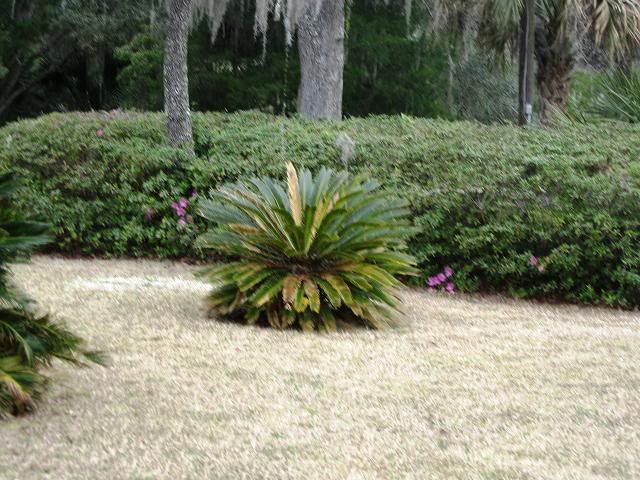
Circling around behind one of the sago palms, I noticed yet ANOTHER electrical line, this time fully exposed and on top of the ground.
Then it moved.
WHOA! WAIT A SECOND! THAT’S NOT AN ELECTRICAL CABLE!
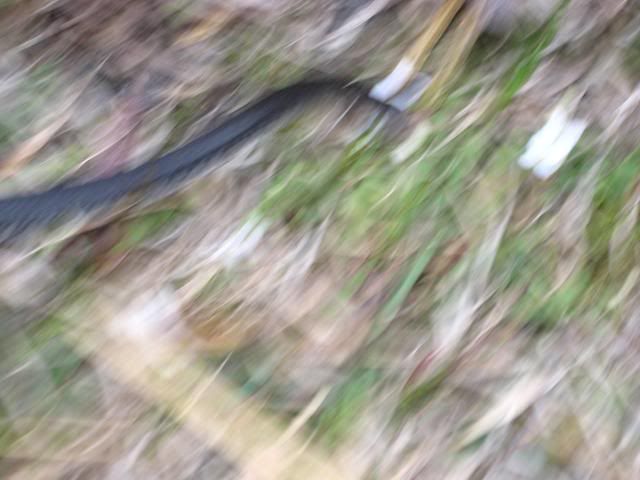
It’s a SNAKE!!!
For me, encountering a live snake in the outdoors is usually followed by a brief adrenaline rush- I guess that's normal. I’m not terrified of them, but I do prefer to keep my distance.
This little guy was no threat, however. He was just a harmless little black snake, maybe ten inches to a foot long, and no bigger around than my middle finger. He seemed remarkably casual about my presence, too. I was able to hold the camera within only about four inches or so of his face, and he never budged, except for the forked tongue flickering.

I prodded him gently with the detector searchcoil, but he still didn’t move. I could have picked him up, had I been so inclined, but I wasn’t. I might not be terrified of snakes, but that doesn’t mean I want to pet them.
This was my third serpentine encounter while out detecting. The first had happened in North Carolina, and was also a black snake, but a much, much larger one- maybe four or five feet long. He too was harmless, but impressive for his size. The second had been just a small green snake, no bigger than today’s encounter, but that one fell from a tree branch across the bill of my cap, and swung back and forth in front of my face for a moment. I’ll admit I jumped back pretty quickly that time!
My next target was a large iron object- something I usually classify as a “rusty-crusty”. Most of the targets I classify as rusty-crusties are unidentifiable, but this was a ring-shaped fitting of some sort. I’m not really sure what it had been used for, but it was obviously very old and had been in the ground a long time.
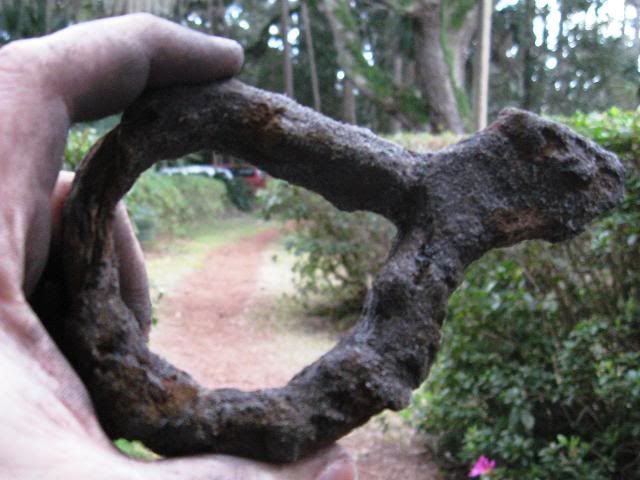
When I had recovered the rusty-crusty ring thing, I'd pinpointed it with the detachable electronic probe that is mounted on my detector’s shaft. The probe has a toggle switch that allows me to switch between it and the main searchcoil. I unknowingly left the switch in the “probe” position rather than switching it back to “coil” when I resumed hunting, which meant for the next ten minutes or so I walked half the circumference of the yard without getting a single signal at all. (This was sort of the equivalent of taking a bunch of pictures with the lens cap of the camera on.)
Finally I realized my mistake and switched the coil back on. I got a shallow coin-range target near the driveway and it proved to be a 1978 Lincoln cent. Then I moved over into the east yard, which had produced most of the silver coins on my last visit.
The next signal was in the middle range of the detector’s meter, meaning it could have been just about anything, but it was clear and repeatable, and had a good depth to it, so I dug. It turned out to be a musketball, which might have been older than the nearby house. It was a “spent” musketball, meaning it had been fired and had traveled its full range before hitting the ground. I could tell this because it was only slightly distorted on one side. I’d say there’s a good chance this was a relic of the old Black Banks plantation rather than the 1876 Gould-Hartridge house whose yard I found it in. Consider that round musketballs and the smoothbore weapons that fired them were militarily obsolete by around the 1850s and were supplanted by the conical “Minie” style bullets used during the Civil war in rifled guns. Sportsmen continued to use the round balls throughout the rest of the 19th century and even to the present day, but this ball had been in the ground a very long time and had the patina old lead gets after a century and a half in the dirt. At least I’d made one good find for the day, even if the old coins (and in fact just about ANY coins) were eluding me.
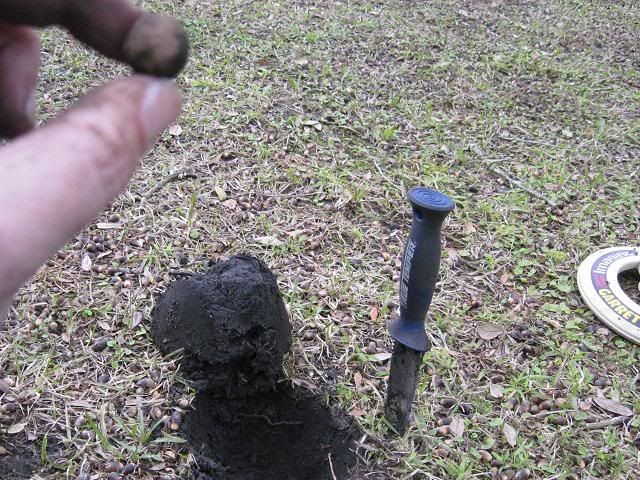
After finding the musketball, I slowed down and worked that area of the yard much more carefully, but encountered nothing but more buried pipelines. Apparently the water pipes in this yard are the older metal kind, instead of modern PVC plastic.
I had to step back abruptly for my second wildlife encounter of the day. It was another harmless critter, but he was doing his best to appear threatening. I'd come upon a fiddler crab in the grass. The males of this species have one giant, oversized claw that they use for fighting and attracting females. When they're waving those mismatched claws around, they look like a fiddler playing his instrument, hence the name. Fiddlers live by the millions in our Marshes of Glynn, and are quite capable of ranging inland a good distance. This guy had no doubt come up out of the marsh behind the house. He was several hundred yards away from the water and mud where one would normally expect to find crabs. He tired of the threat display and chose to use his big claw as a shield, instead. I left him alone and went on my way, resolving to watch my step so I wouldn't accidentally squish him on my next pass.
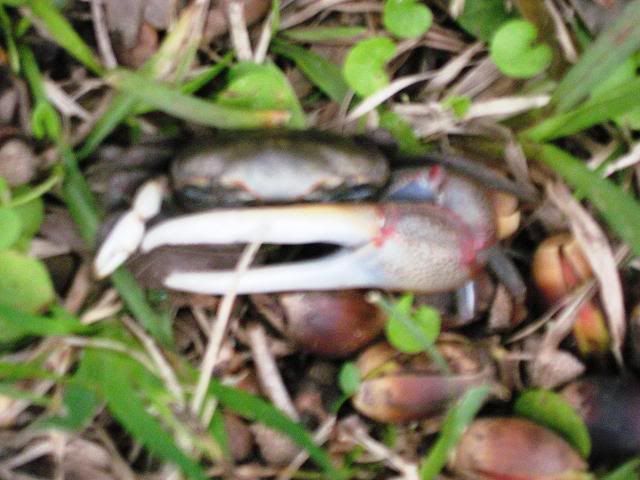
After another twenty minutes or so I was feeling the exhaustion and strain in my back and right arm. The new kneepads my wife got me helped my knees considerably, but I'm still so out of shape and rusty that I'll need to do much more detecting in the near future to get back into the swing of things.
Today's hunt was a bit of a letdown, really, especially on the coin front, with only the one shallow modern Lincoln cent dug. The musketball was a keeper, though, and I love the site- it's beautiful. I got some critter pictures, too, so I am not calling the day a failure. Besides, this site deserves further exploration. When it comes to the yard around the house, I guess I was pretty thorough back in '99, and got all of the "easier" finds, but I am sure there are still some deeper, smaller, and/or more challenging ones there. Maybe next time I won't focus so much on the area around the house and will move outside the fence to search some of the other acreage.
I give thanks to my hosts, and to all of y'all readers, of course.
Stay tuned for the next time I get my hands dirty!
~RWS
INDEX OF DIG STORIES
In the spring of 1999, I had the opportunity to search the yard of the Hartridge residence, which I’m told is the oldest inhabited house on St. Simons Island. The Hartridge’s daughter, Trina, was a classmate of mine in high school and is currently a sales manager where I work. I don’t remember how the subject came up originally, but when Trina mentioned her parents owned land in the Black Banks area of the island, my interest was piqued, as Black Banks was the site of an antebellum plantation. Through Trina’s introduction, I was permitted to hunt the yard of her parents’ home, which was built in 1876, a short distance away from where the original plantation house once stood. It is, to my knowledge, the only Victorian house still standing on the island, though Old Town Brunswick on the mainland has dozens if not hundreds of them.
Though I dug no 19th century coins, the hunting there was very productive, and several silver coins turned up. There were two Barber dimes dated 1914 and 1916. The 1916 was in exceptional condition- almost Mint State, with much of the original luster remaining- and is probably the best Barber dime I’ve found so far. It was probably lost not too long after it was made. (For my non-numismatic readers, I should explain that the “Barber” coins of 1892-1916 get their name from William Barber, the Mint engraver who designed them. Many probably did get spent on haircuts, too, though.)
There were also two “Mercury” or Winged Liberty dimes. The first was only about two-thirds of a coin. It had been melted in a fire and was thin, brittle, and stretched out much larger than a normal dime. The first portion of the date appeared to read “191”, so it would have been struck in 1916 or 1917. It was cracked when I found it, and now, after eleven years in my dug coin album, it has disintegrated into small crumbs of metal. I never found the rest of it. The other Mercury dime was dated 1926.
Another silver coin found was a British shilling from 1941. It bore the portrait of King George VI on the obverse. This type of shilling was made with two different reverse designs: “English” and “Scottish”, and mine had the Scottish lion on it.
There is also a sixth silver coin from around that time in my dug finds book- it is a 1946 Roosevelt dime- but I don’t know if it came up at the Hartridge house or on a subsequent site, since my recordkeeping lapsed for a while.
In summary, this site was very good to me in the past, and I knew I’d been the first to detect there. I also knew I’d barely scratched the surface, and plenty of goodies were sure to remain. Needless to say, I was excited when I was recently granted permission to return.

On Sunday, March 14, 2010, I crossed the Torras Causeway to the island. It was a partly cloudy and rather cool day, and the Bach cantatas playing on my car radio suited the mood nicely. Since metal detecting is a journey into the past, I often listen to classical music to put me in a historical frame of mind.
As I approached the Hartridge house, it didn’t look very different from how it had eleven years before. The entire neighborhood had become a gated community, but little else appeared to have changed.




Mrs. Hartidge greeted me at the gate and offered to show me where the property boundaries lay. It turned out there was a very great deal more property than just the yard around the house. In fact, the whole tract was something like eleven acres. Eleven acres on Saint Simons Island… wow. There aren’t many folks who have tracts of land that size on the island, unless the property has descended through several generations of an old family, which this one no doubt has.
A lot of this acreage is still partially wooded and Mrs. Hartridge said she didn’t believe it had ever been touched by a metal detector. Though I had hunted the yard before, it remained my primary focus for today, since old coins are my chosen quarry, and they tend to be closer to the house in yards like this. Since Mrs. Hartridge graciously extended permission for me to come back anytime I liked, the other parts of the property would definitely bear further investigation later on.
My first target in the yard registered as a good coin signal on the detector’s meter. It proved to be a fragment of an old Mason jar lid, however. The next signal was difficult to pinpoint at first, but it ended up being a buried electrical cable. Fortunately I hadn’t damaged the tough rubber insulation around it. I made a mental note to myself to dig carefully around here, since electrocuting myself or knocking out my hosts’ power didn’t seem like much fun.
In the northwestern corner of the yard, near where a part of the marsh wrapped around the property, there was a lichen-encrusted cedar tree. Beneath it there was a patch of brilliant green grass. It was of a different type than the rest of the lawn, and looked like the stuff used to line kids’ Easter baskets- maybe even brighter than that. It was almost a fluorescent green. I don’t know why a little patch of bright green grass brightened my spirits, but it did. Maybe it's the symbolism behind that whole "looking for greener pastures" thing.

In another sign of spring, the azaleas were beginning to bloom, and the sound of birdsong was in the air. There were several handsome sago palms in the yard. Near one of them, I dug a small brass doodad, which had probably been a part of a zipper. Near another sago palm was a buried pipe, then another electrical line. I was having more luck in finding buried utilities than coins! Usually I can tell from the sound of the signal when something is long and linear like a pipeline or cable, but I just wasn't hearing it in the signals today.

Circling around behind one of the sago palms, I noticed yet ANOTHER electrical line, this time fully exposed and on top of the ground.
Then it moved.
WHOA! WAIT A SECOND! THAT’S NOT AN ELECTRICAL CABLE!

It’s a SNAKE!!!
For me, encountering a live snake in the outdoors is usually followed by a brief adrenaline rush- I guess that's normal. I’m not terrified of them, but I do prefer to keep my distance.
This little guy was no threat, however. He was just a harmless little black snake, maybe ten inches to a foot long, and no bigger around than my middle finger. He seemed remarkably casual about my presence, too. I was able to hold the camera within only about four inches or so of his face, and he never budged, except for the forked tongue flickering.

I prodded him gently with the detector searchcoil, but he still didn’t move. I could have picked him up, had I been so inclined, but I wasn’t. I might not be terrified of snakes, but that doesn’t mean I want to pet them.
This was my third serpentine encounter while out detecting. The first had happened in North Carolina, and was also a black snake, but a much, much larger one- maybe four or five feet long. He too was harmless, but impressive for his size. The second had been just a small green snake, no bigger than today’s encounter, but that one fell from a tree branch across the bill of my cap, and swung back and forth in front of my face for a moment. I’ll admit I jumped back pretty quickly that time!
My next target was a large iron object- something I usually classify as a “rusty-crusty”. Most of the targets I classify as rusty-crusties are unidentifiable, but this was a ring-shaped fitting of some sort. I’m not really sure what it had been used for, but it was obviously very old and had been in the ground a long time.

When I had recovered the rusty-crusty ring thing, I'd pinpointed it with the detachable electronic probe that is mounted on my detector’s shaft. The probe has a toggle switch that allows me to switch between it and the main searchcoil. I unknowingly left the switch in the “probe” position rather than switching it back to “coil” when I resumed hunting, which meant for the next ten minutes or so I walked half the circumference of the yard without getting a single signal at all. (This was sort of the equivalent of taking a bunch of pictures with the lens cap of the camera on.)
Finally I realized my mistake and switched the coil back on. I got a shallow coin-range target near the driveway and it proved to be a 1978 Lincoln cent. Then I moved over into the east yard, which had produced most of the silver coins on my last visit.
The next signal was in the middle range of the detector’s meter, meaning it could have been just about anything, but it was clear and repeatable, and had a good depth to it, so I dug. It turned out to be a musketball, which might have been older than the nearby house. It was a “spent” musketball, meaning it had been fired and had traveled its full range before hitting the ground. I could tell this because it was only slightly distorted on one side. I’d say there’s a good chance this was a relic of the old Black Banks plantation rather than the 1876 Gould-Hartridge house whose yard I found it in. Consider that round musketballs and the smoothbore weapons that fired them were militarily obsolete by around the 1850s and were supplanted by the conical “Minie” style bullets used during the Civil war in rifled guns. Sportsmen continued to use the round balls throughout the rest of the 19th century and even to the present day, but this ball had been in the ground a very long time and had the patina old lead gets after a century and a half in the dirt. At least I’d made one good find for the day, even if the old coins (and in fact just about ANY coins) were eluding me.

After finding the musketball, I slowed down and worked that area of the yard much more carefully, but encountered nothing but more buried pipelines. Apparently the water pipes in this yard are the older metal kind, instead of modern PVC plastic.
I had to step back abruptly for my second wildlife encounter of the day. It was another harmless critter, but he was doing his best to appear threatening. I'd come upon a fiddler crab in the grass. The males of this species have one giant, oversized claw that they use for fighting and attracting females. When they're waving those mismatched claws around, they look like a fiddler playing his instrument, hence the name. Fiddlers live by the millions in our Marshes of Glynn, and are quite capable of ranging inland a good distance. This guy had no doubt come up out of the marsh behind the house. He was several hundred yards away from the water and mud where one would normally expect to find crabs. He tired of the threat display and chose to use his big claw as a shield, instead. I left him alone and went on my way, resolving to watch my step so I wouldn't accidentally squish him on my next pass.

After another twenty minutes or so I was feeling the exhaustion and strain in my back and right arm. The new kneepads my wife got me helped my knees considerably, but I'm still so out of shape and rusty that I'll need to do much more detecting in the near future to get back into the swing of things.
Today's hunt was a bit of a letdown, really, especially on the coin front, with only the one shallow modern Lincoln cent dug. The musketball was a keeper, though, and I love the site- it's beautiful. I got some critter pictures, too, so I am not calling the day a failure. Besides, this site deserves further exploration. When it comes to the yard around the house, I guess I was pretty thorough back in '99, and got all of the "easier" finds, but I am sure there are still some deeper, smaller, and/or more challenging ones there. Maybe next time I won't focus so much on the area around the house and will move outside the fence to search some of the other acreage.
I give thanks to my hosts, and to all of y'all readers, of course.
Stay tuned for the next time I get my hands dirty!
~RWS
INDEX OF DIG STORIES
Collector since 1976. On the CU forums here since 2001.
0
Comments
Collector since 1976. On the CU forums here since 2001.
And by the way...sort of had a "Zot-esque" feel with all the critter pics!
Hope everyone is well in your home!
<< <i>And by the way...sort of had a "Zot-esque" feel with all the critter pics! >>
Those were exactly my thoughts when I was out there! Wait'll Zot sees this!
Hey, where the heck have you been, Rick? I am glad to see you around. Of course I myself was scarce for a long time.
Have you seen all this "Send LordM to England" stuff? Remember how we used to discuss this? Maybe this year is the year for me. It sure would be great if you could come along, too.
Collector since 1976. On the CU forums here since 2001.
<< <i>
<< <i>And by the way...sort of had a "Zot-esque" feel with all the critter pics! >>
Those were exactly my thoughts when I was out there! Wait'll Zot sees this!
Hey, where the heck have you been, Rick? I am glad to see you around. Of course I myself was scarce for a long time.
Have you seen all this "Send LordM to England" stuff? Remember how we used to discuss this? Maybe this year is the year for me. It sure would be great if you could come along, too. >>
Hey Rob! (Mr. LM
I miss those years we had a bunch of characters in here... back when we were competing for the monthly awards. I still get out once in awhile, but not on a regular basis. Figure it's due to time limitations and we all sort of took a break... Still fun to see some of the old gang pop up here from time to time though
Of course I remember our conversations and fun jabs about us needing to make that trip over the pond! I'd love to do that, but things have sure changed over the past few years... 4 kids in the house, and the economy stuff have really moved some things to the back burners. Oh well... hope it works out so you can get over there and we can detect vicariously through you! (that's going to be awesome reading your posts... just loaded with history, and hopefully silver+gold too!) I still pop into the forum here from time to time but when you head over there, I'll be checking regularly.
It will kind of be like the old "Virtual Treasure Hunt" ;-)
Jerry
The first "action shot" of the snake is great - makes you feel just like you were there yourself
I've been lucky enough to never encounter a snake while detecting. *knocks wood*
My worst shock has been a black grouse hen that made an extremely noisy getaway from almost under my nose once, catching me totally off guard.
<-- I looked just like the squirrel in my icon for a while after that...
(Black grouse hen, not my picture)
Better luck with coins on your next visit!
Speaking of which - this was two weeks ago..... it's about time to go back for another bite, eh?
Yes, I do need to get back out there.
<< <i>The first "action shot" of the snake is great - makes you feel just like you were there yourself >>
In fact I had gotten over my initial astonishment over the snake by the time I snapped that first picture, but since it came out so blurry, and unintentionally conveyed that "whoa- jump back!" feeling, I kept it.
See? In keeping with your fine tradition, I got critter pix! On the last outing from 3/29, too! Hopefully my snakey trend will discontinue, though- I'd rather shoot pictures of birds, even though they're faster and harder to get. Didn't you get a red fox, once?
It would be cool if you'd make an index thread of your old dig stories like I did. I wouldn't mind reading some of them again.
Collector since 1976. On the CU forums here since 2001.
Loved the story. Thanks for taking the time to share. Keep uip the great work!!
WTB: Barber Quarters XF
Did you ever make it back out there?
-Bjorn
great read as always. Looks like an awesome place to hit time and time again, but just enough not to wear out your welcome. 11 acres on SSI?!!&%^!! Wow, that's unheard of. I smell all kinds of old stuff on that property. Get back out there!
Too many positive BST transactions with too many members to list.